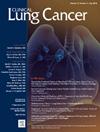Intraoperative Molecular Imaging With Pafolacianine: Histologic Characteristics of Identified Nodules
IF 3.3
3区 医学
Q2 ONCOLOGY
引用次数: 0
Abstract
Background
With increased early detection efforts, surgery for early-stage lung cancer is expected to rise. Pafolacianine is the first FDA approved targeted optical imaging agent indicated as an adjunct for intraoperative identification of malignant and nonmalignant pulmonary lesions in adult patients with known or suspected cancer in the lung.
Methods
This is a retrospective review of the malignant and nonmalignant lesions identified by pafolacianine with intraoperative molecular imaging (IMI) in the multi-center Phase 2 and Phase 3 ELUCIDATE clinical trials. All lesions meeting the intent to treat criteria from the combined studies were included. Histopathology for malignant and nonmalignant lesions and immunohistochemistry (ICH) for folate receptor alpha (FRα) and folate receptor beta (FRβ), which pafolacianine binds to, were assessed.
Results
A total of 273 lesions resected from 191 patients were analyzed. The identification of primary and occult malignant lesions with pafolacianine in combination with standard practice was improved (P < .001) when compared to standard practice alone. A range of histologies were demonstrated including adenocarcinoma (primary and metastatic), squamous cell carcinoma, adenoid cystic carcinoma, chordoma, lymphoma, and papillary thyroid cancer. Ninety-two percent (205 of 223) of lesions tested for folate expression were positive for FRα or FRβ expression.
Conclusions
While initially intended to identify adenocarcinoma, IMI with pafolacianine targets a broad histological cross-section of malignant and nonmalignant primary and metastatic lesions in the lung. As real-world use expands, additional insight will continue to inform utility of pafolacianine in clinical practice and may broaden clinical applicability.
术中分子显像与帕帕拉夏氨酸:已识别结节的组织学特征。
背景:随着早期发现力度的加大,早期肺癌的手术治疗有望增加。Pafolacianine是FDA批准的首个靶向光学显像剂,可作为已知或疑似肺癌成人患者术中恶性和非恶性肺病变的辅助诊断。方法:回顾性分析在多中心2期和3期临床研究中,经术中分子显像(IMI)鉴定的帕帕拉夏氨酸诊断的恶性和非恶性病变。所有符合联合研究治疗标准的病变都被纳入。评估了恶性和非恶性病变的组织病理学,以及叶酸受体α (FRα)和叶酸受体β (FRβ)的免疫组织化学(ICH)。结果:191例患者共切除病变273个。与单独使用标准做法相比,帕帕拉夏氨酸联合标准做法对原发性和隐匿性恶性病变的识别得到改善(P < 0.001)。组织学表现包括腺癌(原发性和转移性)、鳞状细胞癌、腺样囊性癌、脊索瘤、淋巴瘤和甲状腺乳头状癌。在检测叶酸表达的病变中,92%(223例中的205例)的FRα或FRβ表达呈阳性。结论:虽然最初的目的是识别腺癌,但含有帕马嘌呤的IMI针对的是肺中恶性和非恶性原发和转移性病变的广泛组织学横截面。随着实际应用的扩大,更多的见解将继续告知帕帕拉嘧啶在临床实践中的效用,并可能扩大临床适用性。
本文章由计算机程序翻译,如有差异,请以英文原文为准。
求助全文
约1分钟内获得全文
求助全文
来源期刊

Clinical lung cancer
医学-肿瘤学
CiteScore
7.00
自引率
2.80%
发文量
159
审稿时长
24 days
期刊介绍:
Clinical Lung Cancer is a peer-reviewed bimonthly journal that publishes original articles describing various aspects of clinical and translational research of lung cancer. Clinical Lung Cancer is devoted to articles on detection, diagnosis, prevention, and treatment of lung cancer. The main emphasis is on recent scientific developments in all areas related to lung cancer. Specific areas of interest include clinical research and mechanistic approaches; drug sensitivity and resistance; gene and antisense therapy; pathology, markers, and prognostic indicators; chemoprevention strategies; multimodality therapy; and integration of various approaches.
 求助内容:
求助内容: 应助结果提醒方式:
应助结果提醒方式:


